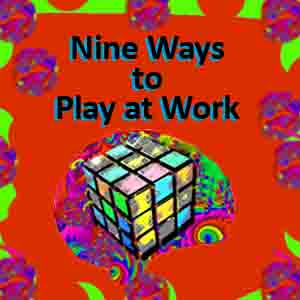 Nine Ways to Play At Work (see list below)
Nine Ways to Play At Work (see list below)
The idea that one should invoke a sense of play around challenges is not a new one. Tim Brown of IDEO did that great TED speech on play, and there have been several more TED play-centric talks (Stuart Brown, John Cohn, Sue Palmer) all variations on the theme. Sunni Brown’s talk on Doodling is a personal favorite because she gets specific about how one can begin to be more creatively playful with problem solving. An emerging trend in business is using improvisation games as the basis for team building and problem solving. The work of Del Close, who shaped the serious play of long form Improv and Viola Spolin, who invented Improv as an art form — is really about using play to learn. They both knew that access to your authentic spontaneous thinking power and play are intimately connected.
My own work with KILN and our IdeaKeg service has to do with holistic play-like experiences that have people mashing up trends and concepts to innovate. This stuff works.
All that said, simple more straightforward ideas for play in day-to-day behavior are harder to come by. That’s what this post is all about. I’ll also admit there is a bit of a smart-ass edge to my suggestions below. Because that’s how I play.
Theory is grand, and, changing behavior is difficult. Playing at work is something that we’ve been trained Not to do and it takes active, daily, thoughtful effort to invoke play — especially when you need it most — with a very serious problem or opportunity. Fear and judgment are the enemies of play and creative effectiveness. That’s why more play is so serious!
Here are Nine Ways to play at work — in which you might do a better job of playing with concepts, challenges, ideas, and solutions. For the sake of brevity I won’t repeat that list, I’ll just say challenge.
- Start making unmerciful fun of the challenge. Out loud. Even if it’s sarcastic, bitter, or angry. Make jokes. It’s a start to playing when you exaggerate or ridicule. Exaggerate so much it makes you laugh because it’s absurd. When you start laughing about a serious challenge, you’ve made a good start. Now, this is best done by yourself or with a group who shares your fear. DO NOT do this to an idea that’s just come out of someone’s mouth. That requires a trust level you may not have. If you have a team that gets what you’re doing, do it. If they don’t get it, explain it first and try again. If they still don’t get it, do it on your own. Or, to hell with em, do it anway, with the group, offend!
- Explore the challenge in a visual way. Draw a picture of it with stick figures. Do a Mind Map or a wall mural. Use crayons and colored markers. Get out the scissors and glue and make a collage. It’s a step away from fear to invoke other modes of thinking. Making things visual is one way to do this. As Sunni Brown says, Doodle. Scribble. Draw a symbol, create a logo. Yes, a logo for the challenge. That’s playing folks.
- Explore the challenge in a physical way. This is almost never done, but find a way to physically explore the challenge. You might literally “walk through” a business process you’re trying to sort out. If it’s a product act out how it’s used, or actually use it. Use the product! Do bad mime if you don’t have it. When in doubt just take a freakin walk. Around the block. Through the park. In the woods. Try to relax and not think so hard about something, be quietly reflective. Walk a Labyrinth (click here for world locator). Here’s a stretch for some of you — create an interpretive dance. It will feel uncomfortable, tough noogies, you’ll laugh, you may get insights, and that’s the point.
- Make a sculpture of it with Play Dough or Model Magic. It’s strange how shaping a blob to mean something, even a conceptual thing that has no literal shape, helps you create a story about it. Many people are kinesthetic thinkers, if you’re one of them this is how you get your play mojo going.
- Flip it. Turn it on it’s head. Playing with a challenge means pushing at it’s edges or turning it upside down. “Wouldn’t it be awful if…” is a way to turn the downside into something positive. Here’s a bit more detail on this item.
- Look at it as if you were five years old. Or get an actual five year old, or even a ten year old, involved. They’ll see things you won’t. The obvious is often obscure to adults, we know too much.
- Look at it as if you are Ghandi. Or Jonathan Winters, or Obama, or Brene Brown. Or that wise teacher you had in eight grade. Put yourself in somebody else’s shoes and allow your thinking to be guided by their wisdom.
- Play out scenarios using Improv games. If you don’t know how to do this, hire some Improv actors, or hire a coach that knows how to use Improv games for problem solving. Here’s more detail on using Improv games. Or, just use a game from the Improv playbook as a way to warm up the group and get the team having fun.
- Gamify it, or make it a contest. Keep it light-hearted, this isn’t about winning, it’s about engaging with a concept. Fun competition is a way to reduce fear.
So, there you have it.
If you are looking for a really fun Keynote Speech, or Workshop. These nine items and the stories and hands-on exercises are meaningful fun. Get in touch! I’ll put play into your next meeting.


